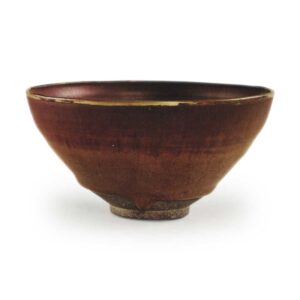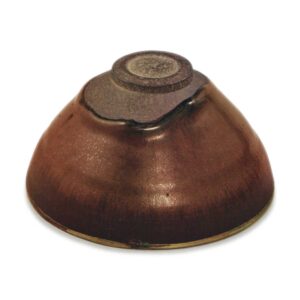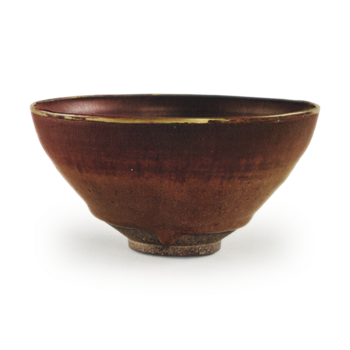

Daimyo-mono
Tokugawa Art Museum
Height: 6.7-7.1cm
Diameter: 13.2-13.3cm
Outer diameter of foot ring: 4.2cm
Height of foot ring: 0.6cm
There are several types of tea bowls known as haikai tenmoku. It seems that they were not all made with the same glaze, but rather that they were all made with different glazes, and that they were all called haikai together. In the past, people did not have detailed concepts, so it seems that they called together all the different types of tea bowls that did not fit into any of the categories of yohen, yudeki, or tōgō, and that in a sense were not up to standard.
They were not actually created by ash falling on them, but rather by the glaze turning grey due to under-firing, or by irregular firing that caused a partial change in the shape of the ware. Therefore, the condition of each tea bowl is different, and it is not possible to recognize any common characteristics. I think that this tea bowl is a particularly unusual example of such haikai ware.
I think this tea bowl should be called a persimmon tenmoku rather than a haikyo, because it shows a glaze tone that is very similar to the persimmon glaze found in the Jōyō and Kanan tenmoku. The reason for this glaze color is that the underglaze of this tea bowl, which is of the Kimachi style, had an unusually high iron content, and in that respect it is the opposite of the yellow tenmoku.
If you look at the glaze surface through a magnifying glass, you can see that the persimmon-colored glaze is not spread evenly over the surface, but consists of a close arrangement of fine persimmon-colored streaks, or rather, lines of iron sand running down the surface, which give the glaze its distinctive appearance. Apart from this, there are also small black spots scattered all over the surface of the glaze, which sparkle like sand, and these are thought to be crystals of iron. During high-temperature firing, the iron content dissolves into the glaze, but when the fire is eventually turned off, it crystallizes into these small dots, which then flow down and appear as the persimmon-colored streaks. In the case of a normal rabbit-hair bowl, the iron content is not as high, so the persimmon-colored streaks show the beautiful rabbit-hair bowl against a black glass glaze, but here the rabbit-hair bowls are stuck together, so it looks as if they are covered in persimmon-colored glaze.
This kind of glaze must have been extremely unusual for Tenmoku ware from the Ken kiln. It seems that the glaze on this tea bowl was not made with this in mind from the start, but that it just happened to have a high iron content. Even so, the glaze pool at the foot of the bowl and the area around the center of the bowl are full of glass glaze, and the streaks of the persimmon-colored glaze flow into the rabbit-ear glaze.
As you can see in the illustration, the color is particularly deep for about 2 cm from the rim on both the inside and outside. If you look closely, there is no difference from the lines of the persimmon-colored streaks below, and it is just a line of iron that has run down, but the color is deeper. This part is the steepest part, and because of this, the glaze layer is thin, and for that reason, it is this deep color, I wonder? It may be related to the underlying clay. Perhaps in the past, people saw this burnt-looking color and put it in the ash pit. In any case, it is a very rare Kenpou.
Sand-glazed bordered rim. Formerly owned by the oil merchant Tsunenobu (Jousuke) of Sakai, it was passed down to the Owari Tokugawa family.



